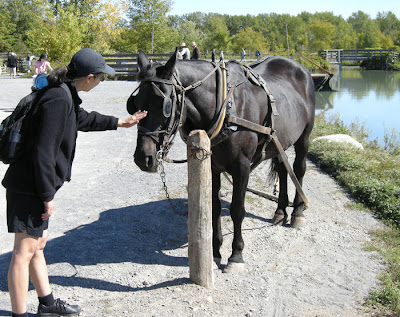
Sunrise at Crysler Park Marina near Morrisburg held promise of a gorgeous day for a visit to nearby Upper Canada Village, a recreation of an Eastern Ontario community in the 1860s.
Click on any image in the blog for a larger view.
By the by, if you want to walk from the marina to the village, don’t believe the 20-minute duration cited in literature and by marina staff. It takes a full 50 minutes to get there, albeit it is a pleasant stroll along the St. Lawrence River.
Happily, our visit coincided with the fall fair. The poster was typeset and printed in the village’s newspaper office. Altogether, the village covers 60 acres and takes at least a half-day to see. Adults $18.95. Seniors $17.95. If you have a CAA card, 10% off.

When we arrive, we have lunch at the Village Cafe: chicken caesar wrap and a ham-cheese panini with home-made potato chips on the side. These are the two largest sandwiches we have ever seen or eaten. Madeleine, our sandwich-maker, is rightly proud of her handiwork. In addition to being huge, they are delicious.
We see and learn all kinds of interesting things about life in Upper Canada at the time of Confederation, but, on occasion, we need to sidestep the horse apples on our walk around the village.
In the course of plowing one acre, a 1860s farmer would walk 10 miles. The village had 30 acres of fields. That’s 300 miles of walking behind the horse and plow.

The Admiral meets Eleanor whose task it is to pull the tow scow along the canal built in the village for demonstration purposes.
We say hello to Buck and Barney, the village oxen, but they ignore us.
One of the principal attractions of the village—at least for two cheeseniks—is the working cheese factory that makes the Upper Canada cheddar that we purchase.
Cheesemaking flourished in 1860s Canada with small operations such as the one at Upper Canada Village. The cheese was eaten locally and exported to England.
Mr. McNight, the apprentice, stirs the curd mixture over several hours. He tells us 900 pounds of milk makes 90 pounds of cheese.
Mr. Kayer, the cheesemaker, loads the curds into a press where it will remain overnight. Then the cheese is aged for months, turning black with mold on the outside. The mold is removed and we are served a very nice cheddar.
We also purchase on excellent whole wheat bread from the village bakery. It’s made with flour produced at the mill on the site. There is also a working sawmill and a small factory to spin wool gathered from the village sheep.
All the guides and interpreters are dressed in period costumes as is this school teacher.
The Admiral hopes she won’t be gored by one of the cows on display at the agricultural fair.
Four hours later, we are ready to head home to At Last! but, after being on our feet for the better part of five hours, we don’t want to walk back. Thankfully, the ticket agent offers to arrange for a ride with the security service that patrols the village.
Before long, the Admiral is husking the corn that will go with the Captain’s first attempt at grilling lamb.
Maybe a bit too long on the grill but otherwise juicy and tasty.
Wednesday, September 23, 2009
Upper Canada Village
Posted by
GxK
at
5:41 PM
![]()
![]()
Subscribe to:
Post Comments (Atom)
Email us
waterworld @ rogers . com

No comments:
Post a Comment